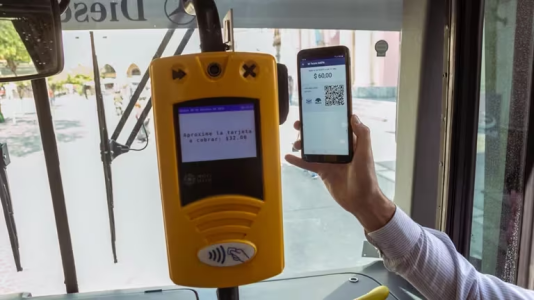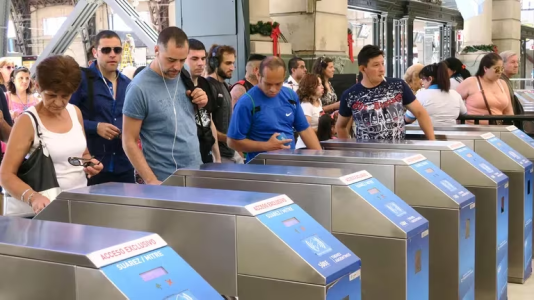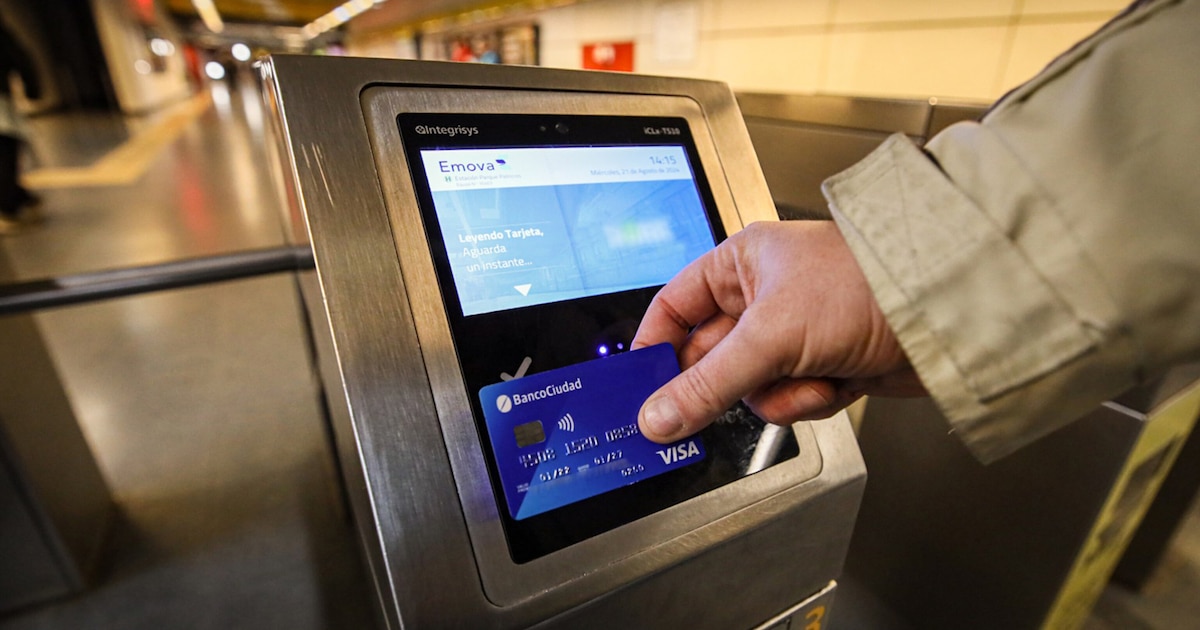The Government wants the bus, train and subway to be paid with debit cards, credit cards and even with QR - Infobae

Source:

 www.infobae.com
www.infobae.com
February 27, 2024
In the midst of the SUBE system crisis, the plan will be developed in parallel to add new payment options. It will include all cards, banking or fintech, and all benefits will be maintained, such as the social rate. The investment will be private: “There is no money,” they reiterate in the government
By Fernano Meaños

In Salta a system already works to pay for the bus with QR
While public transportation users deal with difficulties in using the SUBE card, the Government has a plan in the pipeline so that bus, train and subway tickets can be paid with any means of electronic payment such as debit or credit cards and virtual wallets. Without specific dates since the first steps are being drawn up, the idea does not imply an elimination of the SUBE system but rather the incorporation of all electronic forms of payment, the same ones that Argentines use to make any type of payments in businesses.
“The Government's objective is to advance the interoperability of electronic means of payment for public transport, which includes debit cards, credit cards, QR payments and virtual cards ,” Fernando Blanco Muiño , undersecretary of Consumer Defense, explained to Infobae.
To this end, in recent weeks Blanco Muiño held numerous meetings with chambers of banks, fintechs, card administrators and payment methods companies to begin transmitting the plan. He also did so with other official areas that will participate in the plan, such as the Ministry of Transportation, the Ministry of State Simplification and the Central Bank.
Although there are still many technological questions, the Government's intention is clear. It consists of the transport user being able to choose between all the available payment options , with the same SUBE contactless system . That is why the system must receive all cards and wallets, regardless of their brand, their bank or their modality . That is why it must include all credit, debit and prepaid cards on the market, issued by a bank or a fintech, in addition to QR payments generated through virtual wallets.
Another definition that Blanco Muiño provided is that the new system will be implemented in parallel to the SUBE card, which will continue to operate. The new readers that will be installed on each bus or at each station will continue to receive payments with the SUBE card.
“The plan conforms to what President Milei has been saying: there is no money . Therefore, technological investment will have to be made by companies. And if a reasonable commission is agreed upon, it can be a great deal for all companies, a win-win ,” said Blanco Muiño.
The official stressed that the user will not lose any benefit due to the payment method he chooses every time he takes a bus, train or subway. “People are going to have many more options to pay for their ticket. You can choose between using the SUBE card or any other means of payment. And all the benefits will be maintained, such as the social rate or discounts for those who make more than one trip in a short time or a certain number of trips in the month,” he explained.
In the next 60 days, two pilot tests will be launched to begin testing the needs of transport companies. One of them will be carried out through SBASE, the Buenos Aires government's subway company; another, on buses in the city of Mendoza. At the same time, companies in the sector say that they are waiting for the arrival of different prototypes of card readers to make available to the Government.
Once this process has been completed and with greater certainty about the technological resolution, the process will begin to determine who will provide the service. “ We estimate that by June there may be a call for bids . It may be run by a single supplier or a UTE (transitional business union). The important thing is that the service includes all payment methods on the market and that the consumer is not tied to a single way of paying,” said Blanco Muiño.
Some payment methods companies contradict the official position and assure that instead of there being a single payment acceptance provider, it would be more efficient to approve several companies to provide the service to different transport companies. They highlight that this is a universe that is too extensive to be managed by a single company, and that several companies that compete with each other could do it more easily and even reduce costs. There is also a point to resolve as to whether or not the chosen card reader requires an Internet connection.
This goal of financial inclusion was combined with the growing difficulties of the SUBE card . In addition to the lack of plastic and the complications of loading and then validating the load, there were massive lines in recent weeks to register each card in the user's name, given the threat of losing the subsidy on the ticket.

The plan to pay for transportation with any means of payment comes to alleviate the crisis of the SUBE card, which was launched in 2009. And at that time it came to solve another crisis: the lack of coins , which also generated the image of long lines at the stations, at that time to receive them in exchange for a ticket. The shortage of coins had its origin in a mixture of inflation, subsidies, the black economy that favors cash and some shady businesses of those who could hoard them. The SUBE solved that obstacle but it has already become a problem.
The SUBE system is managed by Nación Servicios and in the transportation sector there is criticism of its operation: “It is expensive and inefficient for what they charge, but Nación Servicios has 1,000 employees and has to sustain that.” They explain that the Banco Nación company charges 7% of the total collection from transporters , a cost that is later reimbursed by the government to the companies within the framework of the subsidy system. Therefore, for transport companies the cost of using the SUBE system ends up being 0, because it is assumed by the State.
“SUBE's technology is now obsolete, no means of transportation in the world uses it. Furthermore, its operation consists of advancing money to the system administrators, in the midst of very high inflation. That always generated a financial business. To put it with a fashionable word, there is a nonsense there ,” explains an executive who knows the subject closely.
It should be noted that in the country there are already precedents for paying the bus ticket directly from a bank account without the intermediate step of loading money to another card. This is the case of Banco Macro in the city of Salta, which through a free app incorporated a QR payment system that does not require an Internet connection either through Wi-Fi or mobile data to pay. Bancor , in the capital of Córdoba, also implemented a system to pay the ticket with a debit card. Last year, Banco Nación had launched a pilot test in Paraná for the same objective.

Source:

El Gobierno quiere que el colectivo, el tren y el subte puedan pagarse con tarjetas de débito, de crédito y hasta con QR
En medio de la crisis del sistema SUBE, el plan se desarrollará en paralelo para sumar nuevas opciones para pagar. Incluirá a todas las tarjetas, bancarias o de fintech, y se mantendrán todos los beneficios, como la tarifa social. La inversión será privada: “No hay plata”, reiteran en el gobierno
February 27, 2024
In the midst of the SUBE system crisis, the plan will be developed in parallel to add new payment options. It will include all cards, banking or fintech, and all benefits will be maintained, such as the social rate. The investment will be private: “There is no money,” they reiterate in the government
By Fernano Meaños

In Salta a system already works to pay for the bus with QR
While public transportation users deal with difficulties in using the SUBE card, the Government has a plan in the pipeline so that bus, train and subway tickets can be paid with any means of electronic payment such as debit or credit cards and virtual wallets. Without specific dates since the first steps are being drawn up, the idea does not imply an elimination of the SUBE system but rather the incorporation of all electronic forms of payment, the same ones that Argentines use to make any type of payments in businesses.
“The Government's objective is to advance the interoperability of electronic means of payment for public transport, which includes debit cards, credit cards, QR payments and virtual cards ,” Fernando Blanco Muiño , undersecretary of Consumer Defense, explained to Infobae.
To this end, in recent weeks Blanco Muiño held numerous meetings with chambers of banks, fintechs, card administrators and payment methods companies to begin transmitting the plan. He also did so with other official areas that will participate in the plan, such as the Ministry of Transportation, the Ministry of State Simplification and the Central Bank.
Although there are still many technological questions, the Government's intention is clear. It consists of the transport user being able to choose between all the available payment options , with the same SUBE contactless system . That is why the system must receive all cards and wallets, regardless of their brand, their bank or their modality . That is why it must include all credit, debit and prepaid cards on the market, issued by a bank or a fintech, in addition to QR payments generated through virtual wallets.
“The Government's objective is to advance with the interoperability of electronic means of payment for public transport, which includes debit cards, credit cards, QR payments and virtual cards” (Fernando Blanco Muiño)
Another definition that Blanco Muiño provided is that the new system will be implemented in parallel to the SUBE card, which will continue to operate. The new readers that will be installed on each bus or at each station will continue to receive payments with the SUBE card.
“The plan conforms to what President Milei has been saying: there is no money . Therefore, technological investment will have to be made by companies. And if a reasonable commission is agreed upon, it can be a great deal for all companies, a win-win ,” said Blanco Muiño.
The official stressed that the user will not lose any benefit due to the payment method he chooses every time he takes a bus, train or subway. “People are going to have many more options to pay for their ticket. You can choose between using the SUBE card or any other means of payment. And all the benefits will be maintained, such as the social rate or discounts for those who make more than one trip in a short time or a certain number of trips in the month,” he explained.
In the next 60 days, two pilot tests will be launched to begin testing the needs of transport companies. One of them will be carried out through SBASE, the Buenos Aires government's subway company; another, on buses in the city of Mendoza. At the same time, companies in the sector say that they are waiting for the arrival of different prototypes of card readers to make available to the Government.
Once this process has been completed and with greater certainty about the technological resolution, the process will begin to determine who will provide the service. “ We estimate that by June there may be a call for bids . It may be run by a single supplier or a UTE (transitional business union). The important thing is that the service includes all payment methods on the market and that the consumer is not tied to a single way of paying,” said Blanco Muiño.
Some payment methods companies contradict the official position and assure that instead of there being a single payment acceptance provider, it would be more efficient to approve several companies to provide the service to different transport companies. They highlight that this is a universe that is too extensive to be managed by a single company, and that several companies that compete with each other could do it more easily and even reduce costs. There is also a point to resolve as to whether or not the chosen card reader requires an Internet connection.
The SUBE and the “tongo”
The Government's plan has a correlation in the private sector, which through different means has been asking for some time to “open” the SUBE system. The local capital banks, gathered in ADEBA, had published a document in June of last year in which they openly asked the then government for “the universalization of means of payment for public transport”, considering that there are 91 million plastic cards issued between banks and fintech.This goal of financial inclusion was combined with the growing difficulties of the SUBE card . In addition to the lack of plastic and the complications of loading and then validating the load, there were massive lines in recent weeks to register each card in the user's name, given the threat of losing the subsidy on the ticket.

The plan to pay for transportation with any means of payment comes to alleviate the crisis of the SUBE card, which was launched in 2009. And at that time it came to solve another crisis: the lack of coins , which also generated the image of long lines at the stations, at that time to receive them in exchange for a ticket. The shortage of coins had its origin in a mixture of inflation, subsidies, the black economy that favors cash and some shady businesses of those who could hoard them. The SUBE solved that obstacle but it has already become a problem.
The SUBE system is managed by Nación Servicios and in the transportation sector there is criticism of its operation: “It is expensive and inefficient for what they charge, but Nación Servicios has 1,000 employees and has to sustain that.” They explain that the Banco Nación company charges 7% of the total collection from transporters , a cost that is later reimbursed by the government to the companies within the framework of the subsidy system. Therefore, for transport companies the cost of using the SUBE system ends up being 0, because it is assumed by the State.
“SUBE's technology is now obsolete, no means of transportation in the world uses it. Furthermore, its operation consists of advancing money to the system administrators, in the midst of very high inflation. That always generated a financial business. To put it with a fashionable word, there is a nonsense there ,” explains an executive who knows the subject closely.
It should be noted that in the country there are already precedents for paying the bus ticket directly from a bank account without the intermediate step of loading money to another card. This is the case of Banco Macro in the city of Salta, which through a free app incorporated a QR payment system that does not require an Internet connection either through Wi-Fi or mobile data to pay. Bancor , in the capital of Córdoba, also implemented a system to pay the ticket with a debit card. Last year, Banco Nación had launched a pilot test in Paraná for the same objective.




